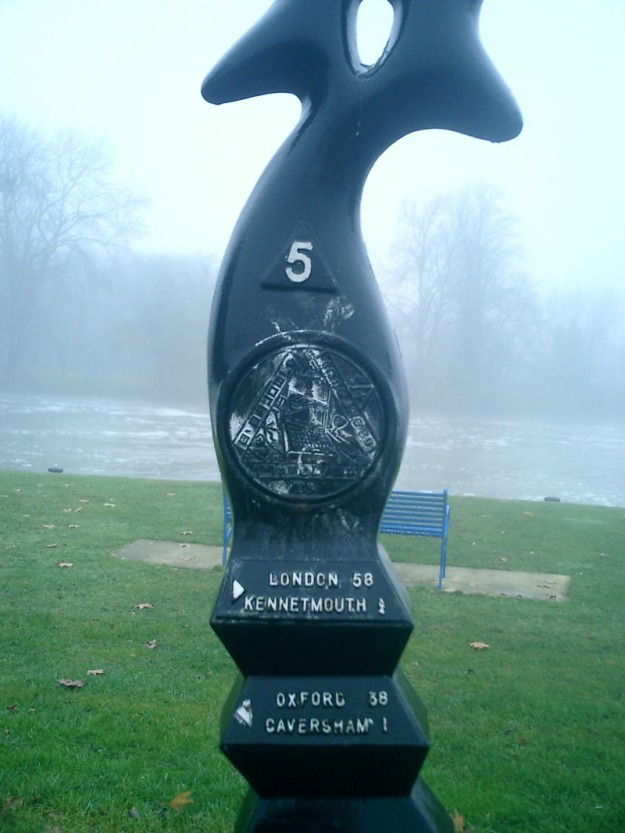Day 1 – Kemble to Castle Eaton, 16½ miles.
Day 2 – Castle Eaton to Newbridge, 23½ miles.
Day 3 – Newbridge to Abingdon, 24 miles.
Day 4 – Abdingdon to Goring, 21 miles.
Day 5 – Goring to Reading, 11 miles.
Day 6 – Reading to Marlow, 18 miles.
Day 7 – Marlow to Staines, 23 miles.
Day 8 – Staines to Richmond, 21 miles.
Day 9 – Richmond to Putney, 8 miles.
Day 10 – Putney to Woolwich, 21 miles.
Day 11 – Woolwich to Crayford Ness, 9 miles.
******
Part 2. (East)
The second half – but still a long way to go. The Thames doesn’t end in London!
Before I go any further with my account, I feel I should come clean. Right from the off I knew I was going to walk the whole thing. I’m sure any other LDWer knows that you can’t just walk some of a LDW, the whole LD of it has to W’d. I did do the first half in 5 days, as an honest and useful test as I’ve already mentioned. But the rest of it now was more about getting the whole thing done, and these bits of it not being far my home I reckoned there was no need to take time off work and plan accommodation etc., I would just do it day by day when it suited me. After all, with a LDW it’s not about how you do it – it’s all about that you do do it! And I did like this…
‘Day 8’ was, for reasons that I now cannot recall, actually the first bit I walked. And ‘day 10’ was split into 3 ‘sub-days’, which I blame on reduced day-light and increased lie-ins. So don’t be alarmed if you notice in the photos summer suddenly turning to late autumn, or it getting dark twice in a day. And perhaps the word ‘day’ here should be taken to read ‘stage’. And also by ‘September 2009’ in the title of this part should more accurately read ‘July – October 2009’. But that’s not as neat. At the end of the day the only rule of LDWing is do what you like! Top
Day 6 – Reading to Marlow, 18 miles.
Once again we head off to Paddington but this time for a much shorter journey out west, and against the tide of the commuters heading east, although at this time of the morning it wasn’t a very strong tide. When I had battled across the town-planned centre seeing the river again was like seeing an old again, albeit a moody old friend who doesn’t say much let alone acknowledge you but one that looks exactly the same as the last time you saw them several, well, weeks before.
 I suppose if you like near the river you’d get used to misty mornings but to me they were always lovely. These trees are in the King’s Meadow – and rural false start as Reading has one last reminder just round in the corner in the form of a huge gas works.
I suppose if you like near the river you’d get used to misty mornings but to me they were always lovely. These trees are in the King’s Meadow – and rural false start as Reading has one last reminder just round in the corner in the form of a huge gas works.
Before the gas works we cross over the Kennet at the aptly named Kennet Mouth. Reading’s urbanisation nearly saw of this little area too, but campaigns to save it won the day and now we can turn right and walk all the way to Bristol if we chose. But we chose to cross over the Horseshoe Bridge and continue eastwards.
For next two days a lock would never be far away, and just as after Sonning Eye is Sonning Lock.


The people at Sonning Lock have very much their own way of letting you know which way the public conveniences are. The guide-book says that Sonning itself – and its fine hostelries – are well worth a detour, its position on a county boundary making for interesting architectural styles. But my schedule made a detour impossible, and the time of the morning would make a detour to the hostelries pretty pointless. That is the one trouble with a well organised LDW (well, wellish), it doesn’t really leave much time for wandering hither & thither as you otherwise may wish. But I suppose the LDW provides plenty of wandering anyways.
 Sonning Bridge is plenty picturesque though, especially in the morning mist and swirling down-weir waters. The boundary stone above is slap in the middle of the bridge.
Sonning Bridge is plenty picturesque though, especially in the morning mist and swirling down-weir waters. The boundary stone above is slap in the middle of the bridge.
The next stretch is one of the bits where the path has to leave the river as the bank is the preserve of the householders here. But one such householder seems more interested in railways rather than water, and has built a rather impressive model railway.


I wonder gauge that is? I waited briefly for the early morning service, but guessed its departure time was still some way so resisting the urge to change the points I carried on to Marsh Lock. The long wooden causeway across the river to it is exactly as the guide-book describes, complete with seagulls. But that didn’t make it unpleasant, in fact it was quite a thrill – like a long stroll out on a seaside pier. And at the other end there was a surprise that wasn’t mentioned in the book…
 … canoeists surfing the rapids! Something I never thought I see on the river, I stood and watched for a moment, vicariously joining in their fun. And it does look rather fun but it’s still far too early for fun for me. In fact most times are probably too early for me for this kind of fun.
… canoeists surfing the rapids! Something I never thought I see on the river, I stood and watched for a moment, vicariously joining in their fun. And it does look rather fun but it’s still far too early for fun for me. In fact most times are probably too early for me for this kind of fun.


The more sedate charms of Henley a little further along are more in-keeping with the general sedateness of the Thames, with its Georgian bridge, boating museum and Hobbs & Sons; proud “waterman to the Queen”. The 16th Century tower of St Mary’s can be seen in the left photo above. On the right is Henley Reach where they have the thing that Henley is most famous for. This is the spot where they regatt, to coin a silly word. Never having seen anything of the Regatta is was still interesting to walk along where they actually do it – in less misty conditions.

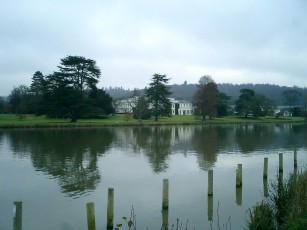
At the end of the Reach if you look carefully you can see a naked lady. She sheltering in the cupola of a temple on Temple Island, and then just a bit further on the other side we pass Greenlands, home of the paperboy-done-well Mr W.H. Smith. I’d been to one of his fine news emporia only that morning and he’d be pleased that business was still brisk nearly 150 after Greenlands was built.
The fields and meadows here are pretty, but pretty unspectacular. Which makes for pleasant and easy if uninspiring walking.


The eye-level rooftops of Culham Farm and the lovely view back at Hambledown make for nice distractions though.
Getting close to Marlow now and my energy levels were flagging a bit so when I saw the Old Bell claiming to have been built in 1153 I just had to pop in for sustenance.


But when I went to the bar and ordered up a half of something or other, and some peanuts the barman said they had none, and offered me olives instead! To be honest inside it looked more like it had been built at 11.53am, so I didn’t linger. Lock Island, on the right, was just around the corner and signalled Marlow and the end of today’s day / stage was nigh.
Arrival in Marlow was timed with the sun getting ready to retire, rather like me. But unlike me it made for a very pleasing sight.

I had a welcome sit-down and a pint or two in the Marlow Donkey pub, while waiting for the Marlow Donkey train to take me back to Maidenhead for the mainline home. The hoards of school children on-board all had energy levels the perfect inverse of mine, but another stretch of the Thames was done. Top
Day 7 – Marlow to Staines, 23 miles.
 Back at Marlow via a much quieter Marlow donkey and the morning is wonderful – crisp and clear, sunny and frosty. Weather to wake you up!
Back at Marlow via a much quieter Marlow donkey and the morning is wonderful – crisp and clear, sunny and frosty. Weather to wake you up!


The frost clears quickly in the sunshine but even so thankfully I didn’t need a sit-down just yet. I wonder if this bench’s river-proximity it proof of global warming? On a day like who cares – Winter Hill looks great in the autumn light. (To viewers in the Granada region: no, not that Winter Hill!)
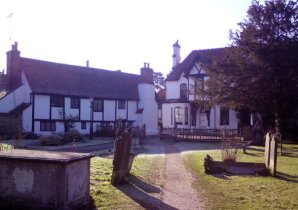

Every now and then the Thames Path wanders away from the river for access reasons, either physical or legal, but when it takes you past Holy Trinity churchyard and into Cookham you don’t really mind. Can you imagine a nicer high street?


Maidenhead comes from the words maiden-hythe meaning ‘new wharf’, which came about when the first bridge was built in the 13th Century. The present Maidenhead road bridge dates from 1777 and rightly deserves its Grade I listed status.
 The best bridge along the whole river has to Brunel’s low-slung wonder the Maidenhead rail bridge, at the time the flattest arches in the world. They said it would collapse but after 170 odd years the InterCities glide over it as effortlessly as Brunel’s 7 footers. To me it looks just like JMW Turner portrayed it – can’t see any hares though…!
The best bridge along the whole river has to Brunel’s low-slung wonder the Maidenhead rail bridge, at the time the flattest arches in the world. They said it would collapse but after 170 odd years the InterCities glide over it as effortlessly as Brunel’s 7 footers. To me it looks just like JMW Turner portrayed it – can’t see any hares though…!


The beauty of Oakley Court (hotel) and a majestic sweep are not spoiled even by a solitary piece of litter.
 A nice stroll into Windsor, but sadly HM wasn’t in today. There were a lot of swans though.
A nice stroll into Windsor, but sadly HM wasn’t in today. There were a lot of swans though.


We all know what happened at Runnymede – 1215 I think the time was – but what I wasn’t so sure about was the purpose the white iron bollard. It is in fact a coal-tax post, and means that after this I’d have to pay duty on any coal I was carrying to the City of London. It also meant therefore that officially I was no back in London – and probably a good time to go home for the day. Incidentally, the locations of the surviving posts might make an interesting LDW in itself. One day… one day. Top
Day 8 – Staines to Richmond, 21 miles.
 As mentioned earlier my trip to Staines was in fact done first of all – a kind of pre-training walk training walk, I think. Which explains the leafy trees and warm skies compared to the Marlow stage. I’d only ever heard of Staines from Ali-G, but it is in fact very nice – the bit along the river anyways.
As mentioned earlier my trip to Staines was in fact done first of all – a kind of pre-training walk training walk, I think. Which explains the leafy trees and warm skies compared to the Marlow stage. I’d only ever heard of Staines from Ali-G, but it is in fact very nice – the bit along the river anyways.

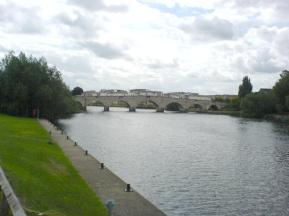
Cli and John’s welcome-bench not long after joining the path was a nice touch, and Chertsey Bridge is most elegant.


I’m not sure which was more thrilling – the duck crossing, or a real-life Dunkirk little ship. Fermain V – was originally Silver Queen – and time I would see her would be in the Jubilee pageant.
 I never thought I’d actually be onboard a river boat on during my river walk, but at Shepperton you need to take the ferry to the other side. It works thus: you ring a bell and then some while later a chap wanders up and ushers you in to his craft for a couple of quid. What fun – and a nice sit down.
I never thought I’d actually be onboard a river boat on during my river walk, but at Shepperton you need to take the ferry to the other side. It works thus: you ring a bell and then some while later a chap wanders up and ushers you in to his craft for a couple of quid. What fun – and a nice sit down.


The river was getting busier and occasionally a bit congested where islands caused it to narrow. This young lad in the dinghy was stalled right in the way as the Richmond Venturer bore down on him blowing her hooter. He looked rightly flustered but managed to get out of the way just in time. The lack of tanks prowling around causing trouble was in part thanks to the tank traps still standing sentry over the river at Molesey.


Further towards Hampton there’s a fine piece of topiary, although I’m not sure what it is. A small boy-pilot commanding a bird-plane? Still a pleasant thing to walk by though, as is Hampton bridge.
 The Hampton ferry seems to run by a similar principle as the Shepperton one although I could see where anyone would appear from if I’d rung the bell. Maybe one of the ducks would have taken me across… But I didn’t need to get to Hampton parish church St Mary’s today anyways.
The Hampton ferry seems to run by a similar principle as the Shepperton one although I could see where anyone would appear from if I’d rung the bell. Maybe one of the ducks would have taken me across… But I didn’t need to get to Hampton parish church St Mary’s today anyways.
 I think I recognise this modest abode – he still got his Hampton caught as they say. I’m glad the ferry took us over to the north bank so we could take a closer look. I was tempted to pop in but no time today, today is for being courted by the Thames, not being tempted by the courts!
I think I recognise this modest abode – he still got his Hampton caught as they say. I’m glad the ferry took us over to the north bank so we could take a closer look. I was tempted to pop in but no time today, today is for being courted by the Thames, not being tempted by the courts!


At Teddington despite the river becoming general dull and suburban – which is only to be expected but doesn’t mean for a moment it’s still not pleasant – there’s still the odd interesting feature to note. On the left is Teddington Lock, which at 650ft long is the largest lock on the river. The guide-book and various internets say that this is the last – or first – lock on the river, and it’s all tidal from here down. But a few miles on the Richmond Lock puts paid to that. But I suppose the mood of the barrier many miles on makes it immaterial anyways. A little further along is the Thames Conservancy Obelisk, which signals that up from here the Environment Agency (nee the Thames Conservancy) are responsible for the river and down from here it falls to the Port of London Authority. I wonder if this ever causes coal-tax arguments based on the coal-tax post a few miles upstream?? It’s interesting little nuggets like this that make the walk so worth-while once the lovely idyll of the Cotswolds has been left far behind.


But there is still the odd pastoral scene to be seen – that’s Grover’s Island near Ham floodplains on the left and the fine Richmond bridge on the right thankfully signals the end of today’s Thames – I had a definite case of Thames walker’s foot, the medical explanation of which is that rivers are for floating down on walking down! Top
Day 9. Richmond to Putney, 8 miles.


A nice short day today, and it starts off in Richmond with a plaque to a special tree – the Asgill House Copper Beech. I’m not sure what makes it special other than it being just rather big & old & nice, but that’s ok with me. Then shortly after we pass the only still functioning drawbridge along the Thames. Well, probably able to function if need be.
 Isleworth Church could’ve been a nice Constabley vista, if it wasn’t for the modern brick in the way now.
Isleworth Church could’ve been a nice Constabley vista, if it wasn’t for the modern brick in the way now.


Any rural illusions are quickly shattered by the high rises of Brentford looming large not far away. Or are these just a mirage themselves? The back view of the unpalatial-looking Kew Palaces leaves me a bit unsure of what is what anymore!
 Strand-on-the-Green looks like a lovely place to live, and I’m sure the estate agents make the most of that!
Strand-on-the-Green looks like a lovely place to live, and I’m sure the estate agents make the most of that!
 People had told me that the Mortlake Brewery – site of brewing since the 15th Century – had closed, even if it had only ‘brewed’ Budweiser of late anyways. It didn’t look like much was going on there, but the air was heavy with a lovely malty smell. So either Bud is still going on or the ghosts of brewers smell like brewers.
People had told me that the Mortlake Brewery – site of brewing since the 15th Century – had closed, even if it had only ‘brewed’ Budweiser of late anyways. It didn’t look like much was going on there, but the air was heavy with a lovely malty smell. So either Bud is still going on or the ghosts of brewers smell like brewers.


At Barnes Bridge some work was going and I was pleased to see they’d done the correct thing according to PLA bye-laws and hung a bale of straw underneath to warn passing sailors of the work going on. The ventilation shaft on the left, presumably from a sewer and presumably Victorian, I just thought made a nice photo.
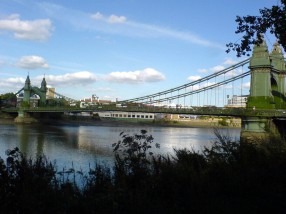

The wonderfully gaudy Hammersmith is best to known to me from the closing credits of Minder, and as we have to cross it we get a nice view of the Harrod’s depository enjoying the afternoon sun.

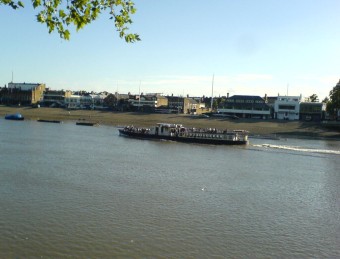
We’ve not seen any cottages by the river since a good county or two and Craven Cottage will surely be the last we’ll see now. When I passed by it was just after Bobby Robson had died, and I didn’t know at the time but he had once played for Fulham but I suspect he was dear to many English football fans.
We’re also now very much in pleasure boating country, both the leisurely and sporting varieties being evident.

A sunny stroll under the old planes of the Bishop’s Park in to Fulham is a very pleasant way to end today’s stretch. Top
Day 10 – Putney to Woolwich, 21 miles.
Today’s bit should be quite manageable in one go, but like I said earlier daylight and lie-in issues meant otherwise! It’s also the bit that goes through the busiest most hectic part of the river and the bits that most people are most familiar with. The bits they think of when they think of ‘The Thames’, but as we are learning there’s a lot more to the Thames than Waterloo Bridge. The day starts by crossing the Fulham Rail Bridge, another bridge well-known to me from my youth from the works of Dennis Waterman. This one from where he duffs up a bent prison officer in The Sweeney – he wasn’t happy. Much like I wasn’t the first time a train rattled by just feet away. Most startling!
The day starts by crossing the Fulham Rail Bridge, another bridge well-known to me from my youth from the works of Dennis Waterman. This one from where he duffs up a bent prison officer in The Sweeney – he wasn’t happy. Much like I wasn’t the first time a train rattled by just feet away. Most startling!


Once over to the south side the autumnal planes of Wandsworth Park are a stark contrast to those of the Bishop’s Park on the other side just ‘a day’ earlier. Incidentally, the path split into two some time ago following either bank. I opted to stay on the south bank, for reasons I can’t remember now – if there was any reason at. I’m glad I did though as otherwise I would have missed one of the grandest porticos and colonnades along the whole path.
 Past the Wandle and the only ship-wreck we’ve seen so far. The 16 mile walk from here to the source of the Wandle is another walk that sounds quite pleasant, in an urbanny way. For another day though.
Past the Wandle and the only ship-wreck we’ve seen so far. The 16 mile walk from here to the source of the Wandle is another walk that sounds quite pleasant, in an urbanny way. For another day though.


In Fulham now and the a very forlorn Fulham Power Station, which hasn’t powered anything since the 70s. And the Albert Bridge, very pretty but so flimsy troops need to be told to march gently over it.
 But of all the power stations along the Thames there can only be one king. Certain sights by the river are always a thrill, and the 1930s art-deco Battersea is up there amongst the best of them. What a beauty. I hope they do something deserving of her.
But of all the power stations along the Thames there can only be one king. Certain sights by the river are always a thrill, and the 1930s art-deco Battersea is up there amongst the best of them. What a beauty. I hope they do something deserving of her.


The river now is getting a little self-aware, and of all these people rushing through this underpass I suspect there weren’t many who could claim to know fully the answer to the question. But I did, oh yes. Alas now the moon was up at Westminster and it time to go home, and first third of this ‘day’ done.


Starting again afresh as if nothing has happened down on the Embankment at Blackfriars Bridge. A bridge notable for because this is where the Fleet comes out underneath, or kind-of does when it’s raining a lot. But it still counts as the mouth of the Fleet.


They’re currently building a new station actually on Blackfriars Railway Bridge, which apparently is very exciting. The iron-oxide columns are from the old bridge, demolished not-so-long ago but the left the pillars there in case it affected the river bed and the new bridge took an unsavoury tilt. The crest of London, Chatham and Dover Railway is another Victorian delight by the river. Funny how few delights are post-Victorian….
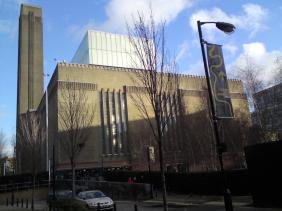

The path take a clearly sign-posted diversion round some weaving back streets and busy main roads, and then past the Tate Modern. None of these things I like! But I was passing so much ‘wonderful’ art, I thought a nice arty-farty shot of St Paul’s and the Wobbly Bridge was in order.
 I can’t say I’m fan of Shakespeare much either – but his new globe is by no doubt the finest piece of Tudor-mockery along the whole way.
I can’t say I’m fan of Shakespeare much either – but his new globe is by no doubt the finest piece of Tudor-mockery along the whole way.


Winchester Abbey and the Golden Hind. The Bishop of geese fame, and Sir Francis Drake respectively.
 London Bridge used to be once upon a time such a splendid thing I don’t think anyone would deny it status as the 8th wonder, but alas now I think it’s one of dullest most perfunctory bridges on the whole river. Oh lovely old Bridge – what hath become of ye? Unless you want to travel to Lake Tavasu to see the new Victorian London Bridge’s home then I do really recommend you pop in to St Magnus the Martyr on the north side, where the old bridge met the City, where they have a huge marvelous model of the bridge built by the Worshipful Company of Plumbers. This in itself might be eligible for a ‘world wonder’ status, perhaps in the 20s or 30s.
London Bridge used to be once upon a time such a splendid thing I don’t think anyone would deny it status as the 8th wonder, but alas now I think it’s one of dullest most perfunctory bridges on the whole river. Oh lovely old Bridge – what hath become of ye? Unless you want to travel to Lake Tavasu to see the new Victorian London Bridge’s home then I do really recommend you pop in to St Magnus the Martyr on the north side, where the old bridge met the City, where they have a huge marvelous model of the bridge built by the Worshipful Company of Plumbers. This in itself might be eligible for a ‘world wonder’ status, perhaps in the 20s or 30s.
 But of course, due to there not being a proper London Bridge anymore, when ever anyone thinks of London and bridges they think of this piece of superb Victorian neo-gothic engineering-wonder. It needs no introduction!
But of course, due to there not being a proper London Bridge anymore, when ever anyone thinks of London and bridges they think of this piece of superb Victorian neo-gothic engineering-wonder. It needs no introduction!


But always be sure to peer through the gap at our river below, and feel the bounce of the buses as they pass. And you may wonder what the blue plate is in the corner of the bridge steps, well I’m reliably informed that it’s to stop gentlemen relieving themselves there. Very clever! All corners should have one, although whether such a busy corner as this needs one I don’t know.
 Below the bridge is Dead Man’s Hole, and it pretty much does what it says on the tin. Except it wasn’t just corpses that were thrown in, plenty of bodies leap in before coming corpses and I’m sure the gates to the Hole are still is use to this day.
Below the bridge is Dead Man’s Hole, and it pretty much does what it says on the tin. Except it wasn’t just corpses that were thrown in, plenty of bodies leap in before coming corpses and I’m sure the gates to the Hole are still is use to this day.


Past the bridge the tree planting near city wall are a little conspicuous, and the trendy expensive flats of Shad Thames make the mind wander with thoughts of what things were like back in the day…


Ominous clouds a-gathering over the glitzy new riverside redevelopments on the north side but St Saviour’s dock is looking a bit more real on the south. Still full of trendy apartments though. There’s a lot of them round here.


Time for some public art in the form of Dr. Salter’s Daydream – but whose stupid idea was it to put out a bench and then put a bronze man on it. He could have easily be stood making more room for weary walkers! But it wasn’t me that stole him! Honest. I much prefer the Jubilee monuments, I trust HM got a new this year too.


Isambard’s small but perfectly formed museum in one of his old pump-houses is well worth a visit, if you like that kinda thing and have nothing better to. The bascule bridge on Rotherhithe Street looks like a little test project for Tower Bridge.
 At Greenland Pier there was a high-pressure airline in the water, and its leaks made it look like there were miniature Thames geysers. I stood a while watching and couldn’t quite figure out what was going on, until the waves retreated slightly and revealed the hose. Bit of a disappointment really!
At Greenland Pier there was a high-pressure airline in the water, and its leaks made it look like there were miniature Thames geysers. I stood a while watching and couldn’t quite figure out what was going on, until the waves retreated slightly and revealed the hose. Bit of a disappointment really!


Another landmark here, and in this case it is quite literally that. It’s the boundary marker between St Paul’s Deptford and St Mary’s Rotherhithe which is also the boundary between Surrey and Kent. Another county crossed! But apparently it’s not in the right place now, but it’ll still do. I have no idea what the thing on the right is, but a big hulk of old rotting timber will also do for me. The steps down were too tempting not to go down and investigate. But I found nothing out. But it is always nice to get down on the foreshore to get a littler closer to the mystical dirty water.
 The clouds over the City were looking very moody now – I wonder they signalled of the financial woes to come? Or had they already started then? I can’t really remember now. Impressive sight though.
The clouds over the City were looking very moody now – I wonder they signalled of the financial woes to come? Or had they already started then? I can’t really remember now. Impressive sight though.


Some sign posts are much help to long-distance traveler, whether or not I was looking for flat 1209. The information at Deptford Creek – the River Ravensbourne – was much more useful. Well, interesting.
 Approaching Greenwich and the river is wide and the skies are big.
Approaching Greenwich and the river is wide and the skies are big.


The Naval College looking splendid and Nelson still standing proud protecting the pub he fought so hard for.


The 17th Century Trinity Hospital is the oldest building in Greenwich, but these is dwarfed by the 20th Century power station which is still in working order.
The mud on the railway-jetty suggests you shouldn’t really be stood on it when there’s a particularly high tide due.
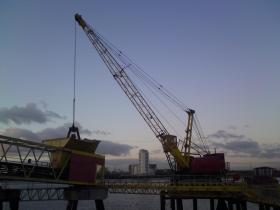

Pleasingly there’s still quite of big dirty industry along this stretch, and just when I’d seen my first working crane I spied a few more on the side. Those ones are engaged in some of the sweetest work on the river – at the Tate & Lyle factory.
 The Thames Barrier designed to prevent flooding and tide-control for Jubilee pageants is a grand sight.
The Thames Barrier designed to prevent flooding and tide-control for Jubilee pageants is a grand sight.
 Looking back dusky London seems a long way away, and the Woolwich ferry signals we reached the end to this penultimate stage. The original Thames Path finished at the Barrier, but since then they’ve tagged on an extension. So it’d be rude not to carry on. Top
Looking back dusky London seems a long way away, and the Woolwich ferry signals we reached the end to this penultimate stage. The original Thames Path finished at the Barrier, but since then they’ve tagged on an extension. So it’d be rude not to carry on. Top
Day 11. Woolwich to Crayford Ness, 9 miles.


We start of the Woolwich arsenal, and if some old target practice was impressive enough how about a bit segment of the Iraqi super-gun that we heard much of a few years back?

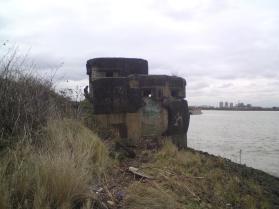
A giant of a river now, but little does it know that we don’t need telling how long it is! We’ve walked each of those 215 miles Mister! Well, most of them – certainly more than the mere 100 miles it claims is possible. I was quite alarmed to read though that the Thames rises over 20 feet every day – I assume though it drops by the same amount too.
I would have loved to known something about this old pillbox though.
 This beacon is at Tripcock Ness – so-called because no cable-hung – or cock-billed – are allowed past this point. Having read this I’m still none-the-wiser to what that actually means.
This beacon is at Tripcock Ness – so-called because no cable-hung – or cock-billed – are allowed past this point. Having read this I’m still none-the-wiser to what that actually means.


I wonder if the people of Inverness know we’re still thinking of them 1191 miles away? Although by my reckoning 1191 miles would get you to Inverness and back…
Across the way we see the Barking Creek flood barrier drawn high over the River Roding. There are more flood barriers on the Thames than you might think!

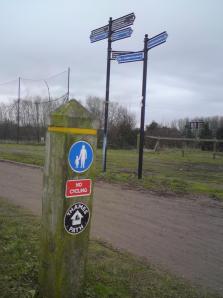
I you can make out the sign-posts on the right, they seem to be suggesting that you may not cycle along the National Cycle Way. But if you’ve just ridden 1200 miles from Inverness you probably wouldn’t want to anyways.


Sewage solutions new and old. Bazagette’s fine Crossness Pumping Station – oh to look inside! and the new and silly looking Crossness Sewage Incinerator – oh to get away!


What leaves the modern sewage plant is as attractive as it is, only more appealing if you’re a seagull.
 They’ve put up a little history lesson up here showing what the river was like in the times of mammoths, but if those are glaciers in the background then the Thames is just newly arrived here from its original course through St Albans – and those ladies are very hardy to go wading in to the water bare-legged. The vandals had made it clear what they thought of it.
They’ve put up a little history lesson up here showing what the river was like in the times of mammoths, but if those are glaciers in the background then the Thames is just newly arrived here from its original course through St Albans – and those ladies are very hardy to go wading in to the water bare-legged. The vandals had made it clear what they thought of it.


I don’t think we’ve seen any fords on the river as yet but they don’t come much bigger than this one – the Dagenham motor plant. And perhaps this anchor was left by a skipper in a hurry to ditch it before he got to Tripcock Ness?
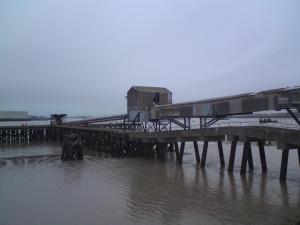

Signs of life and industry are starting to thin out now, but there are still odd bits and pieces and that make you wonder what went on there. Indeed what is still going on in there? There are lights on but is anyone at home? It all feels very mysterious indeed especially in the failing light.


More mysteries are conjured up by what’s been going on here…
 A rainy late afternoon by the time we reach Erith and the prom is deserted.
A rainy late afternoon by the time we reach Erith and the prom is deserted.


The trickles in the mudflats are like scale models on the Thames itself. But is London really that far away?? Told you the Thames doesn’t just end there.
 At the River Darent at Crayford Ness, and the last flood barrier, we spy the mighty QEII bridge in the distance which is as high above the water as the central span of Tower Bridge is wide, we reach the end of the Thames Path. The final end. No more after this, no extensions, nothing. No sign, no plaque, no celebration, no fan-fare. That’s it. Over. But we know we’ve walked the full length of Thames, from source to (almost) the sea, and that’s enough. Now we’ve just got lengthy walk to Dartford station to look forward….
At the River Darent at Crayford Ness, and the last flood barrier, we spy the mighty QEII bridge in the distance which is as high above the water as the central span of Tower Bridge is wide, we reach the end of the Thames Path. The final end. No more after this, no extensions, nothing. No sign, no plaque, no celebration, no fan-fare. That’s it. Over. But we know we’ve walked the full length of Thames, from source to (almost) the sea, and that’s enough. Now we’ve just got lengthy walk to Dartford station to look forward….
So long Thames, it’s been fun! Top
But don’t forget to claim your congratulatory patch or certificate to show off in the pub!



